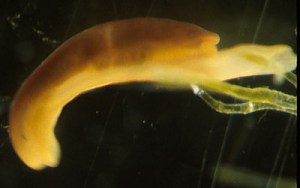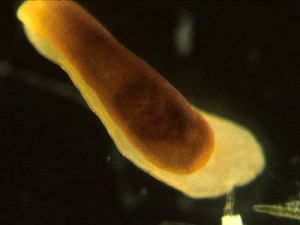Photos of Runcina macfarlandi
May 2, 2001
From: Cynthia Trowbridge


Hi!
In June and July 1990, I found several specimens of Runcina macfarlandi Gosliner, 1991 in high intertidal rock pools at Seal Rock and Boiler Bay State Parks on the central coast of Oregon, USA. These animals were found on the green macroalga Cladophora columbiana (previously called C. trichotoma)that forms thick mats in around rockpools where the sacoglossan Aplysiopsis enteromorphae (previously known as A. smithi) commonly occurs. In fact, I was surveying the rock pools for Aplysiopsis at the time (see Trowbridge 1993a,b) and had examined hundreds of such pools. Since I had a search image for larger black sacoglossans, I may have overlooked some of the smaller brick-red slugs (3-5 mm) in the larger pools.
Anyway, Terry graciously agreed to look at the slugs for me as I had no idea what the slugs could be. I appreciated his help and was delighted to hear the animals were indeed unusual.
For the interest of the more general audience, the Runcina (and Aplysiopsis) were in the same type of high rockpools (with the branching green alga Cladophora or the unbranching alga Chaetomorpha) where Ercolania felina (=Stiliger felinus) are in New Zealand (Trowbridge 1994), Ercolania boodleae and Aplysiopsis spp. in Japan, and Limapontia in Europe. I do not know if Runcina actually eats the alga - any thoughts Bill? - if so, perhaps we should continue to look in the high rockpools for this elusive animal.
• Trowbridge, C.D. 1993a. Feeding Ecology of the Ascoglossan Opisthobranch Aplysiopsis enteromorphae (Cockerell & Eliot): Patterns of Distribution and Impact on Tidepool-dwelling Green Algae. J. Exp. Mar. Biol. Ecol., 169: 233-257.
• Trowbridge, C.D. 1993b. Population Structure of Two Common Species of Ascoglossan (= Sacoglossan) Opisthobranchs on the Central Coast of Oregon, USA. The Veliger, 36(2): 99-106.
• Trowbridge, C.D. 1994. Life at the Edge: Population Dynamics and Salinity Tolerance of a High Intertidal, Pool-dwelling Ascoglossan Opisthobranch on New Zealand Rocky Shores. J. Exper. Mar. Biol. Ecol., 182: 65-84.
Cordially,
Cynthia
Oregon State University
trowbric@ucs.orst.edu
Trowbridge, C., 2001 (May 2) Photos of Runcina macfarlandi. [Message in] Sea Slug Forum. Australian Museum, Sydney. Available from http://www.seaslugforum.net/find/4278Thanks Cynthia,
These little runcinids are fascinating animals. Yes they are all herbivores, but I don't know of any that live quite as high on the shore as R. macfarlandi. I don't recall finding the common New Zealand species Runnica katipoides in high pools with Ercolania felina. It was usually lower down feeding on filamentous green algae living in coralline algae turf. The relationship of the runcinids to other herbivorous cephalaspideans is rather a puzzle because although they all have similar horny, non-calcified gizzard plates, runcinids have four plates whereas all others have three.
• Rudman,W.B.,1971. Structure and functioning of the gut in the Bullomorpha (Opisthobranchia). Part 1. Herbivores. Journal of Natural History, 5: 647-675.
Bill Rudman
Related messages
-
Re: Cynthia's message on Runcina macfarlandi
From: Bill Rudman, May 2, 2001
